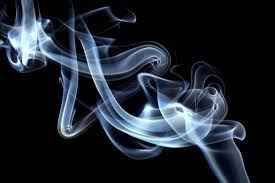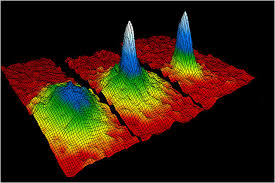The four fundamental states
Solid
Solid-state materials are commonly grouped into three classes: insulators, semiconductors, and conductors. (At low temperatures some conductors, semiconductors, and insulators may become superconductors.)
Liquid
A liquid is one of the states of matter. The particles in a liquid are free to flow, so while a liquid has a definite volume, it does not have a definite shape. Liquids consist of atoms or molecules that are connected by intermolecular bonds.
Gas
Gas is a state of matter that has no fixed shape and no fixed volume. ... When more gas particles enter a container, there is less space for the particles to spread out, and they become compressed. The particles exert more force on the interior volume of the container. This force is called pressure.
Plasma
Plasma is a state of matter that is often thought of as a subset of gases, but the two states behave very differently. ... But unlike ordinary gases, plasmas are made up of atoms in which some or all of the electrons have been stripped away and positively charged nuclei, called ions, roam freely.
Non-classical states
Glass
Nowadays, "glassy solid" or "amorphous solid" is considered to be the overarching concept, and glass the more special case: Glass is an amorphous solid that exhibits a glass transition. Polymers are often amorphous. Other types of amorphous solids include gels, thin films, and nanostructured materials such as glass.
Liquid crystal states
A liquid crystal is a state of matter between liquid and solid (a "mesophase"). ... Liquid crystals are composed of organic, rod-shaped molecules that align in parallel, and the common types used in electronic displays are nematic, cholesteric and smectic.
Microphase-separated
Microphase separation is the term used to describe the type of chain segregation which is able to occur in block and graft copolymers in the bulk state and in concentrated solution, and the structures generated by the packing of domains on the macrolattice are termed mesomorphic structures.]
Low-temperature states
Superfluid
A superfluid is an exotic state of matter with unusual properties. It has zero viscosity, which means it can flow across a surface and not slow down — or lose any energy — due to friction with the surface. Superfluids, such as liquid helium, must be cooled to extremely low temperatures for such properties to emerge.
Bose–Einstein condensate
A Bose-Einstein condensate is a group of atoms cooled to within a hair of absolute zero. When they reach that temperature the atoms are hardly moving relative to each other; they have almost no free energy to do so. ... Instead, the atoms fall into the same quantum states, and can't be distinguished from one another.
Fermionic condensate
A fermionic condensate, or fermi condensate, is a state of matter (superfluid phase) which is very similar to the Bose–Einstein condensate. ... The only difference is that Bose-Einstein condensates are made up of bosons, and are social with each other (in groups, or clumps).
Rydberg molecule
This latest discovery reveals a new state of quantum matter called a “Rydberg polaron,” a relatively giant particle containing many atoms that behaves in some ways like a single massive particle. ... These highly excited atoms were immersed in a gas that had been cooled to just a millionth of a degree above absolute zero.
Quantum Hall state
Nearly a century later, researchers earned a Nobel Prize for the uncovering special resistance-free conducting states, quantum in origin, that occur when at very specific magnetic fields. Known as the quantum Hall effect, these states, observed in two-dimensional structures, corresponded to new states of matter.
Photonic matter
Photonic matter is a phenomenon where photons interacting with a gas develop apparent mass, and can interact with each other, even forming photonic "molecules". ... This is in contrast to photons moving in empty space, which have no rest mass, and cannot interact.
Dropleton
Part particle, part liquid, a newly discovered "quasiparticle" has been dubbed a quantum droplet, or a dropleton. The dropleton is a collection of electrons and "holes" (places where electrons are missing) inside a semiconductor, and it has handy properties for studying quantum mechanics.
High-energy states
Degenerate matter
Degenerate matter is a highly dense state of fermionic matter in which particles must occupy high states of kinetic energy to satisfy the Pauli exclusion principle. The description applies to matter composed of electrons, protons, neutrons or other fermions.
Quark matter
An extremely dense phase of matter made up of subatomic particles called quarks – may exist at the heart of neutron stars. It can also be created for brief moments in particle colliders on Earth, such as CERN's Large Hadron Collider. But the collective behaviour of quark matter isn't easy to pin down.
Color-glass condensate
"At some point, the splitting of gluons inside the proton reaches a limit at which the multiplication of gluons ceases to increase. Such a state is known as the color glass condensate, a hypothesized phase of matter that is thought to exist in very high-energy protons and as well as in heavy nuclei."
Other states
Supersolid
A supersolid is a special quantum state of matter where particles form a rigid, spatially ordered structure, but also flow with zero viscosity.
String-net liquid
In condensed matter physics, a string-net is an extended object whose collective behavior has been proposed as a physical mechanism for topological order by Michael A. Levin and Xiao-Gang Wen. A particular string-net model may involve only closed loops; or networks of oriented, labeled strings obeying branching rules given by some gauge group; or still more general networks.
Superglass
Search Results
Featured snippet from the web
A superglass is a phase of matter which is characterized (at the same time) by superfluidity and a frozen amorphous structure. J.C. Séamus Davis theorised that frozen helium-4 (at 0.2 K and 50 Atm) may be a superglass















0 Comments:
Post a Comment
Subscribe to Post Comments [Atom]
<< Home